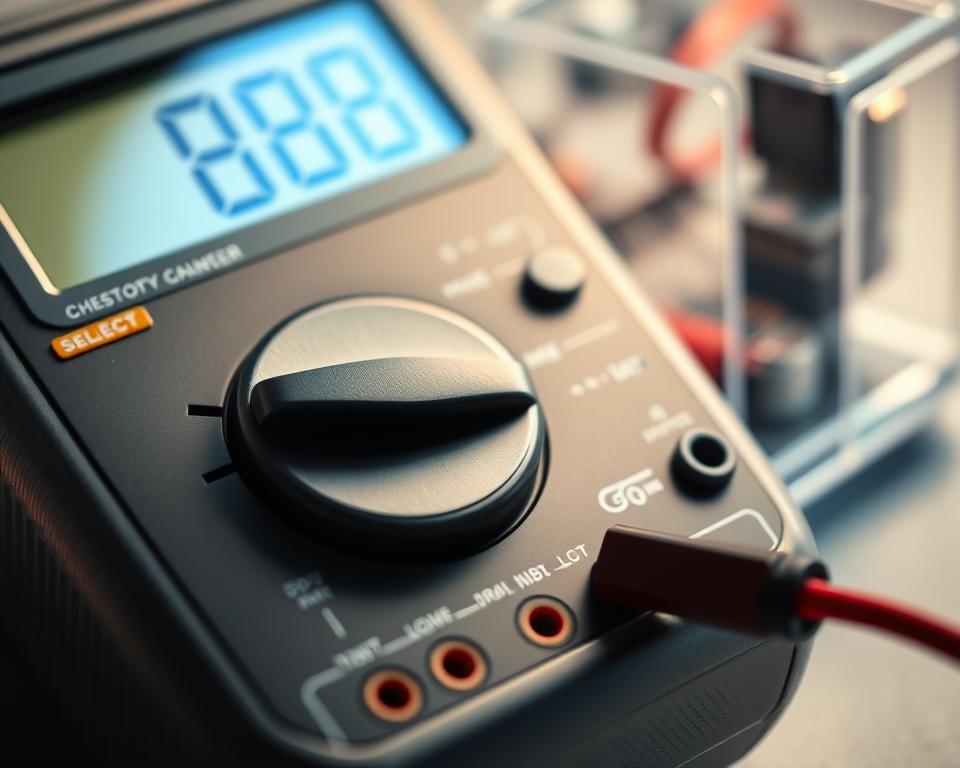Multimeter Uses: Essential Capabilities Explained
The average multimeter can measure up to 20V in voltage levels. Yet numerous projects, notably in innovation and electronics, utilize less than 200mA of current. This observation highlights the essential role multimeters serve in electrical testing and problem resolution. Understanding how to operate a multimeter is crucial, not just for technicians and designers, but also for pupils examining electrical concepts.
Multimeters are irreplaceable in their flexibility, offering accurate measurements of voltage, current, and resistance. This article will examine the numerous roles and functions of a functions of a multimeter. It seeks to supply you with the knowledge to efficiently operate this essential tool in your circuit experiments and projects.
Critical Findings
- Multimeters are crucial tools for gauging voltage, current, and resistance.
- Understanding multimeter usages is essential for successful troubleshooting.
- Digital multimeters are popular for their clarity and precision in displays.
- Safety measures are critical when using a multimeter for electrical testing.
- Continuity evaluation is an important function for verifying electrical connections.
- Selecting the right multimeter can notably impact your testing efficiency.
Introduction to Multimeters
A multimeter is vital for diagnosing electronic faults and ensuring devices function properly. It gauges various electrical properties, essential for both specialists and DIYers.
Explaining a Multimeter?
A multimeter combines instruments to assess electrical potential, current, and resistance. This assists considerably in resolving electronic faults. Available in traditional and digital models, multimeters are crucial. Analog models use a needle and scale for gauging, whereas digital ones display readings on a screen. They test wall outlets, batteries, and other electronics.
Value of Multimeter in Electrical Testing
In electrical testing, the role of a multimeter is of utmost importance. It assesses system continuity and detects faults in various environments. For example, in the automotive sector, it checks battery potential and sensors. It also guarantees industrial machinery operates smoothly, preventing costly breakdowns.
Multimeters, crucial for testing, determine AC and DC voltage, current, and resistance. Their capability to manage diverse tasks makes them invaluable for both basic and complex projects.
Varieties of Multimeters
Understanding the various types of multimeters is vital for effective electrical testing. They are divided into two primary classes: analog and digital multimeters. Each provides distinct attributes and perks. Therefore, choosing the right type is determined by your particular demands and inclinations.
Analog Multimeters
Analog multimeters include a dial indicator and analog dial. They are excellent for observing quickly varying values. Their configuration enables users to see variations as they transpire. Analog devices boast a measurement span typically between one thousand to 50,000 ohms per volt, with the peak sensitivity attaining 20K Ω/V. This made them favorites for broadcast engineers in the mid-20th century.

Digital Multimeters
Due to their exactness and capability, digital multimeters have evolved into highly favored. Their LCDs display readings unambiguously and can show up to four digits. They can gauge diverse parameters like voltage and thermal readings. Furthermore, advanced models offer auto-ranging, recording data, and wireless capabilities. This makes them ideal for intricate applications in fields like automotive diagnostics and sustainable energy.
Contrast of Traditional and Digital Multimeters
Choosing between analog and electronic multimeters is contingent upon your specific requirements and budget. The table below summarizes their key differences:
| Feature | Analog Multimeters | Digital Multimeters |
|---|---|---|
| Visual Output | Pointer indicator on dial | Digital readout (LCD) |
| Accuracy | Good, but less precise | High precision and resolution |
| Reaction Time | Quick response to fluctuations | Depends on sample frequency |
| Applications | Ideal for fast-shifting values | Adaptive, used in multiple fields |
| Expense | Generally lower | Fluctuates considerably, but can be more costly |
Although both multimeter types are crucial for electrical testing, digital multimeters’ precision and power have rendered them more favored among practitioners in both consumer and professional spaces.
Elements of a Multimeter
Grasping the essential parts of a multimeter is crucial for its efficient use. It includes multiple main components, each with a specific role. The visual panel delivers readings, while the function selector allows users to switch between functions like voltage, current, and resistance. Probes link the device to the circuit being evaluated, representing another vital feature.
Key Parts and Their Operations
The primary components of a multimeter are divided into:
- Display Panel: Exhibits values in live for simple analysis.
- Selection Knob: Lets users choose the setting, including voltage, current, or resistance functions.
- Connectors: Typically three, but some models have four for linking various probes.
- Measurement Leads: Critical for attaching the multimeter to electrical systems, with the red probe for positive and black for ground connections.
Grasping Multimeter Probes
Probes play a fundamental role in multimeter performance. They are offered in multiple types, such as standard or alligator clips. The red probe is employed in testing voltage or resistance; the black serves as a ground. Using alligator clips streamlines tasks involving several components, improving measurement precision and effectiveness.
Operation of the Selection Knob
The selection knob is crucial for accessing the device’s functions. By rotating the knob, users can switch between AC and DC voltage measurements, current checking, or resistance testing. Choosing the proper setting is essential for exact readings. Users must exercise caution with the range setting to prevent device harm or inaccurate results.
Capabilities of a Multimeter
For anyone engaged in electrical testing, familiarity with the multimeter’s functions is essential. These devices deliver critical measurements for properly examining electrical parts. They measure voltage, examine current, and inspect resistance, establishing their importance for both commercial applications and DIY projects.
Gauging AC and DC Voltage
Measuring both AC and DC voltage is a fundamental function of multimeters. They deliver remarkable exactness, with the capability to notice subtle changes. This is essential for ensuring that electrical devices operate safely within their designated potentials.
Assessing Current Measurement
Current measurement is more complex than voltage. You must interrupt the circuit flow where you want to measure, as the multimeter integrates into the circuit in series. Choose the proper range, marked in amperes or milliamps. Securely affix the multimeter probes between the discontinuities of the circuit.
Grasping Resistance Measurement
Testing component functionality, like resistors and capacitors, is accomplished by resistance measurement. Multimeters can measure resistance up to a range of megaohms, which is essential for evaluating circuit integrity and executing continuity tests.
Continuity Testing Capabilities
Continuity testing is vital for troubleshooting. It utilizes audio signals or display cues to denote electrical connections. This secures that circuits function as intended, facilitating effective diagnostics.
| Operation | Analog Multimeters | Electronic Multimeters |
|---|---|---|
| Voltage Measurement | Measures AC and DC voltage with remarkable exactness | Evaluating power supply in devices |
| Current Measurement | Assesses electrical flow in circuits | Checking battery voltage and sensor functionality |
| Resistance Measurement | Tests the functionality of circuit components | Ensuring resistors and diodes are within tolerance levels |
| Continuity Testing | Assesses electrical connections | Assessing circuit integrity |
Employing a Multimeter Without Risk and Properly
Comprehending how to handle a multimeter is essential for anyone involved with electrical systems. Proper procedures secure safety and precise readings. When gauging voltage, current, or resistance, each step necessitates particular safeguards.
Primary Safety Guidelines
Acquiring safety precautions before using a multimeter is vital. Your multimeter should be rated for your job setting. Unfortunately, over a significant portion of electricians use inadequately rated tools, risking danger. To ensure safety, always ensure the multimeter is accurately adjusted before connecting probes.
Steps for Measuring Voltage
Measuring voltage requires careful precision. First, select the proper multimeter range for the voltage, AC or DC. Insert the probes into the right ports: the common and voltage-specific jacks. Then, connect the probes accurately to the circuit.
Steps for Measuring Current
Current measurement is more intricate than voltage. You must interrupt the circuit path where you want to determine, as the multimeter joins the circuit in series. Choose the proper range, marked in amps or milliamps. Securely attach the multimeter probes between the discontinuities of the circuit.
Steps for Testing Resistance
To precisely evaluate resistance, remove the component in question. Switch the multimeter to resistance mode, then attach the probes to the component. A matching reading signifies that the component is in good condition; otherwise, it might be malfunctioning. This precaution mitigates multimeter damage and guarantees correct electrical flow analysis.
Typical Uses of Multimeters
Multimeters are essential in both commercial and domestic contexts for a diverse array of activities. They excel in analyzing electrical circuits, establishing their indispensability. These devices are pivotal in detecting and correcting electrical problems, ensuring systems function properly.
Resolving Electrical Issues
Multimeters primarily help in diagnosing electrical circuit issues. Technicians and DIY enthusiasts depend on them to pinpoint problems. By assessing voltage, current, and resistance, they identify faulty parts, securing proper operation.
Testing Batteries and Energy Supplies
Assessing batteries is a crucial application for multimeters. They measure voltage to determine automotive or household battery energy level. This allows users to ascertain if a battery works well or is failing, improving energy management.
Checking Circuit Integrity
For security and efficiency, verifying circuit integrity is key. Multimeters assess this by testing continuity and resistance. They spot issues such as broken wires or defects, prompting timely fixes. Overall, multimeters boost both the safety of installations and circuit troubleshooting.
Choosing the Appropriate Multimeter for Your Requirements
Selecting the suitable multimeter improves your effectiveness in electrical testing. Key factors to consider include accuracy, range of measurements, mobility, and user-friendliness. Unlike analog meters, digital multimeters excel in functionality, adored by technicians and hobbyists.
Key Considerations
Essential factors in choosing a multimeter include:
- Accuracy: Digital multimeters offer high precision, sensing variations as small as 1 millivolt.
- Range Options: Select models that handle multiple electrical measurements like voltage, current, and resistance.
- Compactness: Opt for compact, easy-to-carry designs for portable use.
- Usability: Auto-ranging and illuminated screens enhance a better user experience.
Popular Models: Cen-Tech 7 Function Digital Multimeter
The Cen-Tech 7 Function Digital Multimeter is known for its versatility and cost-effectiveness. It combines essential features appealing to both beginners and professionals. Additionally, its auto-ranging function simplifies measurements, optimizing task execution.
This model’s scaling capability reaches up to 20,000, ensuring precise readings for a wide range of electrical jobs. It excels in troubleshooting, automotive tests, and battery checks. Its combination of noteworthy features and simplicity of use makes the Cen-Tech 7 Function Digital Multimeter a top pick for a new investment.
Final Thoughts
Grasping multimeter functions is key for those involved with electrical tasks. We’ve encapsulated multimeter functions, emphasizing their value in testing and safety. Their precision in gauging voltage, current, and resistance is invaluable. Thus, multimeters are essential for both professionals and enthusiasts.
Multimeters surpass mere assessments. They deliver advanced functionalities like data logging and wireless connections. These features enable wide-ranging uses, from car diagnostics to exploiting renewable energy. Additionally, capabilities for continuity and frequency checks are instrumental in detecting defects, guaranteeing systems operate seamlessly.
Armed with this insight, individuals can effectively utilize their multimeter proficiency for precise troubleshooting and improving safety protocols. They can also boost the efficiency of electrical setups and upkeep. Essentially, multimeters’ versatility establishes their indispensability in achieving precision in electrical jobs.
Frequently Asked Questions
What core operations does a multimeter perform?
A multimeter primarily measures voltage (AC and DC), current, and resistance. It also executes continuity tests. These functions are vital for identifying circuit issues and checking circuit health.
How should I decide between analog and digital multimeters?
Choosing between analog and digital multimeters depends on your needs. Analog types are ideal for showing swift changes in value. In contrast, digital models deliver accurate digital outputs. This establishes their preference for daily tasks.
How can I ensure safety while using a multimeter?
When using a multimeter, always choose the appropriate mode before connecting. Avoid touching live wires when testing current. Also, isolate sections before resistance tests to prevent inaccurate readings.
Can a multimeter test batteries?
Yes, testing batteries is a frequent application for multimeters. They measure voltage to display charge level. This guarantees that your power sources are dependable for various needs.
What is continuity testing, and why is it important?
Continuity testing verifies electrical connections in a circuit using a multimeter. It’s essential for finding and fixing breaks. This guarantees that your electrical setups operate as intended.
What parts does a multimeter usually consist of?
A multimeter typically comprises a measurement screen, a function selector knob, probe ports, and the probes. The probes make contact with the circuit being evaluated.
What sets the Cen-Tech 7 Function Digital Multimeter apart from other models?
The Cen-Tech 7 Function Digital Multimeter is easy to use and offers versatile functions, including auto-ranging. It’s budget-friendly, making it a good choice for experts and DIYers.

